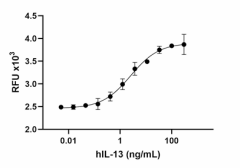- Other Names
- ALRH, BHR1, P600, IL-13, MGC116786, MGC116788, MGC116789, IL13

-

GMP recombinant human IL-13 induces the proliferation of human TF-1 cells in a dose-dependent manner. The ED50 for this effect is 0.5 – 3.0 ng/mL.
| Cat # | Size | Price | Quantity Check Availability | ||
|---|---|---|---|---|---|
| 571114 | 25 µg | $928.00 | |||
| 571116 | 100 µg | $2300.00 | |||
Select size of product is eligible for a 40% discount! Promotion valid until December 31, 2024. Exclusions apply. To view full promotion terms and conditions or to contact your local BioLegend representative to receive a quote, visit our webpage.
Initially cloned from cDNA libraries of activated T cells, human IL-13 is an immunoregulatory cytokine produced by Th2 type helper T cells in response to signaling through the T cell antigen receptor and by mast cells and basophils upon cross-linkage of the high-affinity receptor for immunoglobulin E (IgE). IL 13 is a key mediator in the pathogenesis of allergic inflammation sharing many functional properties with IL-4 including the alpha subunit of the IL-4 receptor (IL-4Rα). IL-13 mediates its effects by interacting with a complex receptor system comprised of IL-4Rα and two IL-13 binding proteins, IL-13Rα1 and IL-13Rα2. Ligation of the IL-13 receptor complex results in signaling via the insulin receptor substrate (IRS)-1 and 2 and STAT-6 pathways. IL-13 has been implicated in airway hypersensitivity, mucus hypersecretion, inflammatory bowel disease, and parasitic nematode expulsion. In vitro studies suggest IL-13 decreases SARS-CoV-2 entry to bronchial epithelial cells.
Product Details
- Source
- Human IL-13, amino acid (Gly21-Asn132) (Accession: # X69079) was expressed in E.coli.
- Molecular Mass
- The 112 amino acid recombinant protein has a predicted molecular mass of 12.3 kD. The DTT-reduced and non-reduced protein migrate at approximately 9 kD by SDS-PAGE. The N-terminal amino acid is Gly.
- Purity
- > 95%, as determined by Coomassie stained SDS-PAGE.
- Formulation
- 0.1 µm filtered protein solution is in 10 mM NaH2PO4, 150 mM NaCl, pH 7.2
- Concentration
- 25 µg and 100 µg sizes are bottled at 0.5 mg/mL
- Storage & Handling
- Unopened vial can be stored between 2°C and 8°C for up to 2 weeks, at -20°C for up to six months, or at -70°C or colder until the expiration date. For maximum results, quick spin the vial prior to opening. The protein can be aliquoted and stored at -20°C or colder. Stock solutions can also be prepared at 50 - 100 µg/mL in appropriate sterile buffer, carrier protein such as 0.2 - 1% endotoxin-free BSA or HSA can be added when preparing the stock solution. Aliquots can be stored between 2°C and 8°C for up to one week or stored at -20°C or colder for up to 3 months. Avoid repeated freeze/thaw cycles.
- Activity
- Human IL-3 induces proliferation of human TF-1 cells in a dose-dependent manner. The ED50 for this effect is 0.5 – 3.0 ng/mL.
- Application
-
Bioassay
- Application Notes
-
BioLegend carrier-free recombinant proteins provided in liquid format are shipped on blue-ice. Our comparison testing data indicates that when handled and stored as recommended, the liquid format has equal or better stability and shelf-life compared to commercially available lyophilized proteins after reconstitution. Our liquid proteins are validated in-house to maintain activity after shipping on blue ice and are backed by our 100% satisfaction guarantee. If you have any concerns, contact us at tech@biolegend.com.
- Disclaimer
-
GMP Recombinant Proteins. BioLegend GMP recombinant proteins are manufactured in a dedicated GMP facility and compliant with ISO 13485:2016. For research or ex vivo cell processing use. Not for use in diagnostic or therapeutic procedures. Our processes include:
- Batch-to-batch consistency
- Material traceability
- Documented procedures
- Documented employee training
- Equipment maintenance and monitoring records
- Lot-specific certificates of analysis
- Quality audits per ISO 13485:2016
- QA review of released products
BioLegend GMP recombinant proteins are manufactured and tested in accordance with USP Chapter 1043, Ancillary Materials for Cell, Gene and Tissue-Engineered Products and Ph. Eur. Chapter 5.2.12.
Antigen Details
- Structure
- Monomer
- Ligand/Receptor
- IL-4Rα, IL-13Rα1, and IL-13Rα2
- Bioactivity
- Human IL-13 induces the proliferation of TF-1 cells
- Cell Sources
- IL-13 is secreted by activated T cells, Th2 cells, basophils, mast cells, activated eosinophils and NK cells
- Cell Targets
- IL-13 receptors are expressed on human B cells, basophils, eosinophils, mast cells, endothelial cells, fibroblasts, monocytes, macrophages, respiratory epithelial cells, and smooth muscle cells
- Antigen References
-
- McKenzie ANJ, et al. 1993. P Natl Acad Sci USA. 90:3735.
- Papasavvas E, et al. 2005. J. Immunol. 175:5532.
- Kelly-Wellch, et al. 2005. Science Signaling. 2005:293.
- Hershey GK. 2003. J Allergy Clin Immunol. 111:677.
- Harris J, et al. 2007. Immunity. 27:505.
- LaPorte SL, et al. 2008. Cell. 132:259.
- Jackson DJ, et al. 2020. J Allergy Clin Immunol. 146:203. e3.
- Bonser LR, et al. 2022. Am J Respir Cell Mol Biol. 66:391.
- Regulation
- IL-13 modulates human monocytes/macrophages and B cells. IL-13 induces an increase of MHC class II expression in human monocytes/macrophages, and direct inhibition of inflammatory cytokines such as TNF-α and IL-1β
- Gene ID
- 3596 View all products for this Gene ID
- UniProt
- View information about IL-13 on UniProt.org
